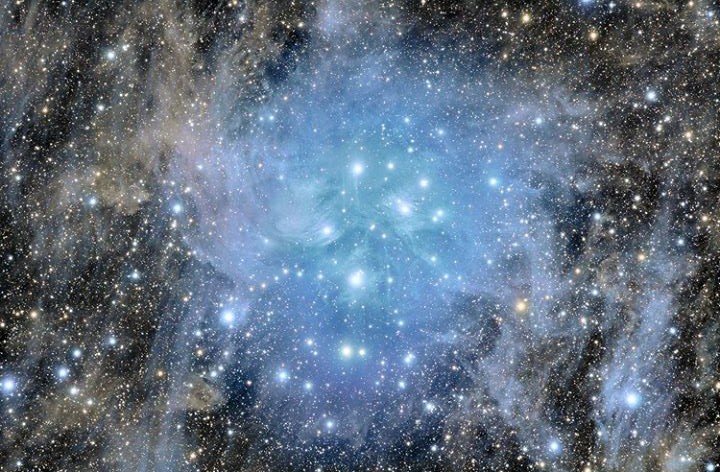

This is the Pleiades star cluster as you’ve never seen it before — in deep field! Also known as M45 or the Seven Sisters, Pleiades is probably one of the most famous and well-studied star clusters in the galaxy. Although it lies some 400 light-years away from Earth toward the constellation of Taurus, it can still be seen with the naked eye in cities that have mild to severe light pollution problems. Get away from the lights of big cities, one should easily be able to see the brightest six stars of the cluster. Obviously, there are many more stars than just the seven (although the exact number remains unknown). An additional 1,000 stars, which span about 43 light-years in radius, have been confirmed (together, they have an estimated mass of about 800 individual suns).
This particular image of Pleiades was taken with an exposure of about 30 HOURS. It covers a portion of sky that is several times larger than the size of a full moon. The massive stars contained within the region are very hot, metal-poor stars that live fast and die young, spewing large quantities of gas and heavier elements out into the interstellar medium once they go supernova. Some of which, shine hundreds of times more brightly than the sun does. The faintest of the bunch is still 40 times more luminous than the sun would appear from the same distance, with Alcyone being over 1,000 times more luminous!
As an interesting side note; most people are only able to clearly make out six of the stars in the Pleiades cluster. Regardless, over the years, speculation surfaced concerning the existence of a seventh star that could be easily made out in the cluster. If this is the case, It’s possible that the seventh star could be a variable star (like our sun is). Meaning, it varies in brightness over time. It’s also possible, in theory, that the “missing” star isn’t missing at all, but that the star is hidden from view by thick pockets of interstellar dust grains.
And some more fun information:
The Legend of Pleiades:
“The name Subaru is Japanese, meaning ‘unite’ – but it’s also a term for a cluster of six stars in the Taurus constellation, named ‘Pleiades’ by the Ancient Greeks. At the time, these stars were thought to represent the seven daughters of Greek mythological figures Atlas and Pleione.”
[From: Constellations of Words]
The Seven Sisters of Pleiades:
Alcyone – Meaning ‘queen who wards off evil’, Alcyone is the central and largest star of the Pleiades constellation. She is often seen as representing the whole cluster of stars.
- Asterope – A double star in the Pleiades constellation, literally translates as ‘lightening’.
- Merope – The only Pleiad to marry a mortal, her star shines less brightly than those that represent her sisters.
- Maia – The eldest of the Seven Sisters, Maia was said to be the most beautiful. According to Greek myth, Maia was a lover of Zeus and gave birth to Hermes.
- Taygeta – After being defiled by Zeus while unconscious, Taygeta went into hiding. For her protection, she was transformed into a doe.
- Celaeno – Celaeno was married to Poseidon. Translated, her name means ‘darkness’ or ‘blackness’. Celaeno is sometimes referred to as the Lost Pleiad, as her star is sometimes difficult to see with the naked eye.
- Electra – The third brightest star in the constellation, Electra means ‘amber’, ‘shining’ and ‘bright’. Electra was the wife of Corythus. She was seduced by Zeus and gave birth to Dardanus, who became the founder of Troy.